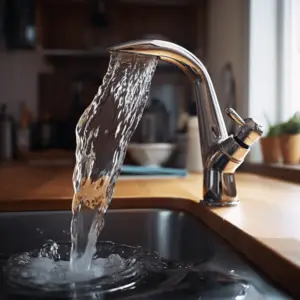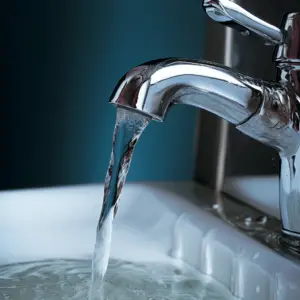Table of Contents
Introduction
A leaky faucet can be a real pain. No one wants to hear that constant dripping sound. So, let’s get into the easy and effective ways to solve this common problem.
Leaky faucets not only cause annoyance, but they also increase your water bills. So, it’s important to fix them right away. The first step is to turn off the water supply valves under the sink. This will help you work on the faucet without any trouble.
Second, you need to figure out the type of faucet you have. There are four main types: compression, ball, cartridge, and ceramic-disc. Each type needs a different approach to fix it. Identifying it will help you choose the right method for repair.
Now that you know the type of faucet, let’s talk about how to fix it. A worn-out washer or O-ring is often the reason for a leaky faucet. To fix this, you need to take apart the faucet and replace the components. If the valve seat is faulty, you’ll need to grind or replace it.
Also, mineral deposits can build up and damage your faucet. So, clean and descale your faucet regularly. Make sure to use the right tools and follow safety measures when working on your faucet.
Reasons for a leaky faucet

Drip-drip! Annoying, right? But what causes a leaky faucet? Let’s look into it.
- Worn-out washers: These rubber discs can deteriorate, making water seep and cause leaks.
- Loose parts: Screws, nuts, and other components may become slack over time, leading to water leakage.
- Corroded valve seat: Connects with the spout and can corrode due to mineral deposits. This can result in leaks from the base.
- Damaged O-rings: Located near the valve stem, when they wear out or break, they cause leaks around the handle.
Some faucets have unique issues, e.g. cracks in ceramic discs. Check your model and potential concerns.
Regularly clean your faucets and check for any damage. If you’re not sure how to fix it, get professional help.
Important: Remember to turn off the water supply using shut-off valves before attempting any repairs. This prevents water damage during fixing.
Tools and materials needed
To repair a leaky faucet, you’ll need the right tools and materials. Here are five must-haves:
- Adjustable wrench. Used to loosen nuts and bolts, needed to remove faucet parts.
- Screwdriver set. Different types to disassemble various faucets.
- Replacement parts. O-rings, washers, cartridges, and more.
- Plumber’s tape. Aka Teflon tape, creates a watertight seal when reassembling plumbing.
- Bucket or towels. To catch any water that spills during the repair.
Plus, a flashlight will help you see inside the faucet better. These items mean you’re ready to fix your leaky faucet!
Long ago, ancient civilizations had simple clay or metal tools to control water flow. Later, the Industrial Revolution saw more sophisticated faucets with washers and valves. Nowadays, leaky faucet repairs are a popular DIY project.
Preparing to fix the leak
Steps to fix a leak:
- Gather the right tools and materials. Wrenches, screwdrivers, parts, plumber’s tape, and cleaning items are a must.
- Turn off the water supply to prevent any accidents or damage. Find the main water valve and turn it off.
- Clear a workspace for easy maneuvering.
- Research online to get tips and precautions.
- Inspect other parts to prevent future issues.
- My own experience showed a faulty O-ring was causing the drip. I was doubtful at first. But, I followed instructions carefully. I prepared well by gathering necessary tools and turning off the water supply. I fixed the leak without any complications.
Step-by-step instructions
Fixing a leaky faucet? No problem! Just follow these three easy steps:
- Turn off the water supply. Find the shut-off valve under your sink. Close it by rotating it entirely counterclockwise.
- Disassemble the faucet. Remove any caps or handles. Use a screwdriver to unscrew screws and take off the handle. Use pliers to loosen and take off the packing nut. Check for damaged parts like O-rings or washers and replace them.
- Reassemble and test. Carefully put back together the faucet in reverse order. Tighten all screws and nuts securely. Turn on the water supply slowly and check for any leaks. No more drips? You’ve successfully fixed your faucet!
Tip: Have a plumbing repair kit with spare parts like O-rings, washers, and gaskets. This way you can quickly fix leaks without going to the store.
Testing the repaired faucet
- To test if the fix was successful, turn on the water supply at the shut-off valve.
- Inspect for leaks around the faucet’s base and connections.
- Turn on hot and cold water separately and check the temperature doesn’t fluctuate.
- Adjust the water pressure and test any settings like spray or aerated flow.
- After turning off the faucet, observe if the water drains completely.
- To prolong its lifespan, clean the faucet regularly with a damp cloth and mild soap.
- Follow these steps to effectively test and maintain your repaired faucet. This can help save you from plumbing headaches in the future.
Preventative maintenance tips

Inspect your faucet often! Watch for any signs of wear or damage. Clean it with a mild soap and water solution. If leaks appear, tend to them quickly. Apply some silicone-based lubricant on the movable pieces. Get rid of mineral deposits with an overnight soak in vinegar. Replace worn-out parts immediately.
Be aware of any faucet-specific cleaning instructions. Maintenance may prevent costly repairs. A leaking faucet caused by a worn O-ring taught me this. Replacing it solved the problem.
Prevention is key. Follow these tips and stay proactive to protect your faucet and your wallet!
Conclusion
- Figuring out how to fix a leaky faucet is key for any homeowner. Follow the steps in this article and you’ll save water and money. You’ll also boost your self-assurance regarding your plumbing skills!
- It’s smart to do regular maintenance to avoid leaks. Check and replace washers or cartridges. This way, you’ll have smooth functioning faucets.
- Water waste due to leaks is bad for the environment. A tiny drip may seem small, but it adds up. So take prompt action. You’re preserving resources and helping conservation.
- The EPA says an average household leaks 10,000 gallons of water per year. That’s enough for 300 loads of laundry.
- By following these tips, you can fix a leaky faucet and save water. As responsible homeowners and protectors of our environment, let’s strive to do this diligently. Every drop counts!
Frequently Asked Questions
Q: How can I fix a leaky faucet?
A: To fix a leaky faucet, start by turning off the water supply to the faucet. Then, use a wrench to disassemble the faucet and examine the parts for any damage or wear. Replace any faulty parts, such as washers or O-rings, and reassemble the faucet. Turn the water supply back on, and the leak should be fixed.
Q: Why is my faucet leaking?
A: Faucets can leak for several reasons. The most common cause is a worn-out washer or O-ring. Other potential causes include a loose valve or a faulty cartridge. Mineral deposits or corrosion can also lead to leaks. Identifying the exact cause will help determine the appropriate fix.
Q: Can I fix a leaky faucet myself, or do I need a professional plumber?
A: Many leaky faucet issues can be fixed by homeowners without the need for a professional plumber. Simple repairs such as replacing washers or O-rings are often DIY-friendly. However, if you’re not comfortable with plumbing tasks or the issue is complex, it’s best to consult a professional plumber to avoid causing further damage.
Q: How much does it cost to fix a leaky faucet?
A: The cost of fixing a leaky faucet can vary depending on the severity of the problem and whether you hire a professional plumber. Simple DIY repairs can cost as little as nothing if all that has to be done is to replace a washer, but more involved repairs, such as those that involve replacing cartridges or valves, can be more expensive. Hiring a plumber may involve additional labor and service charges.
Q: Are there any temporary solutions to stop a faucet from leaking?
A: Tightening the faucet handle or using a tool to snugly tighten connections can temporarily halt a leaky faucet. Band-aids are transitory.
Q: How can I prevent my faucet from leaking in the future?
A: Maintenance prevents faucet leaks. Turning the faucet handle too hard might cause wear. To avoid clogs, clear mineral deposits and debris regularly. To avoid more damage, fix leaks immediately.

